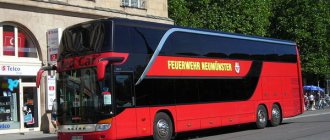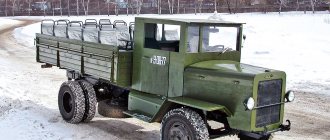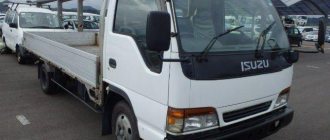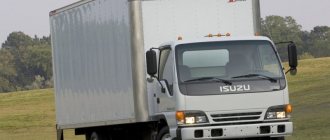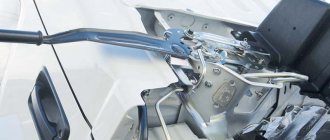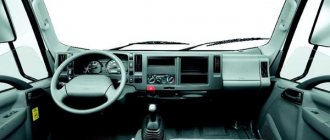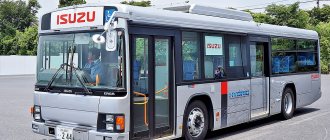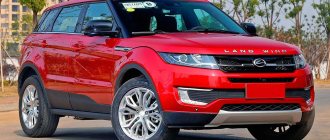Stages of company development
The history of the Isuzu brand began in 1916, after the release of the first passenger car. A couple of years later, the company began producing cargo models commissioned by the state. The first line of these machines was called A-9. The most popular model appeared in 1928. It was called "Sumida".
Car brand Isuzu
Important dates in the history of the famous Asian brand:
- 1950 – invention of an improved combustion chamber and water cooling technology.
- 1953 - the beginning of technical cooperation between Isuzu and the British company Rootes, as a result the first passenger model was assembled.
- 1959 – development of the Elf all-terrain truck with an economical diesel engine (DA640), which brought commercial success.
- 1961 – Isuzu creates the first engine with a large displacement (1991 cc), for which it receives recognition.
- 1963 – release of the Bellett passenger car.
- 1967 – invention of an improved truck engine, release of the Florian passenger car.
- 1971 – the brand sells part of its shares to General Motors.
- 1974 – the Gemini passenger car was created jointly with American colleagues.
- 1975 – opening of the company's branch in the USA.
- 1980 – Introduces the Fargo line of minivans, followed by the Piazza three-door coupe.
- 1985 – First Rodeo Bighorn SUV.
- 1990s - the Isuzu brand is recognized as a global leader among truck manufacturers.
- 1998 – due to the difficult situation in the world, the production of passenger models was suspended, the brand began mass production of trucks. GM's shareholding increases. Opening of a company branch in Poland.
- 2001 – the brand's engine entered the top ten according to Ward's Communications.
- 2002 – repeated award, a business plan for the next 3 years was developed.
- 2003 - GM sells part of its shares and creates a joint venture. Cooperation with Mazda Motor Corporation. Start of bus production.
- 2004 – a new line of environmentally friendly passenger cars. The brand celebrates the production of its millionth diesel engine.
- 2005 - opening of a branch in Malaysia (direction - commercial vehicles).
- 2006 – termination of the agreement with GM. Start of production of environmentally friendly heavy trucks. Opening of a subsidiary in Ukraine.
- 2010 – cooperation with Kazakhstan (CBC-Group) for the sale of commercial equipment.
Now Isuzu is focusing on the production of SUVs, minivans, vans up to 3.5 tons and pickups.
History of the brand
In the history of this auto concern, which has long collaborated with General Motors, there have been many successful models, such as the Isuzu Trooper/Bighorn. And many of us know Isuzu Amigo as Opel Frontera.
We lead to the fact that the company is known precisely for the production of very good SUVs and crossovers. And many of them have already become classics of the world automotive industry. Every Isuzu car that has rolled off the assembly line over the past 100 years (the company has been around since 1916) can be considered a pride and an achievement.
So, as you already understand, the history of victories began with Amigo/Mu. This happened back in 1989, and in 1998 the second generation of popular cars saw the light. The car had a convertible top and permanent all-wheel drive. It also had an independent spring rear suspension.
A year earlier, another legendary car appeared on the same base. This is the famous VehiCross jeep. It also had a plug-in automatic all-wheel drive and a distinctive slats frame that was not afraid of any loads. The car had an independent torsion bar suspension at the front, and a solid axle at the rear on gas monotube shock absorbers, which also had an additional external chamber. Before Isuzu, no one had installed such an option on production cars. The company became a pioneer and its name thundered throughout the world.
By 2001, another new product was prepared. The basis for it was the proven Trooper, and they called it Isuzu Axiom. The axiom of success looked very convincing, and the car was optimized in such a way that the suspension was successfully used both in urban areas and off-road.
Cooperation with GM led to the appearance of the Isuzu Ascender based on the GMC Envoy XL. Released in 2002, the Jeep was rugged and very reliable. Its frame was made by hydroforming. The rear suspension is a solid axle with 5 levers, the front suspension is spring, independent.
We should not forget that the company began with the production of trucks. And I never forgot about this direction. The late 1980s saw a surge in the popularity of pickup trucks. Isuzu simply had no right to miss this moment. And to test the waters, a kind of test car of the TF series was released. The test of the pen turned out to be successful and the cars were produced for fourteen years, starting in 1988.
Two-door, two-seat Single Cabs, four-seat Space Cabs, and 4-door/5-seat Crew Cabs were produced. The cars were produced in both rear-wheel drive and 4x4 versions. By 2002, it was decided to release a new pickup truck to replace the already obsolete, but still popular TF. The car was called D-Max.
The new Isuzu D Max turned out to be very successful. It was also produced with different types of cabin. The single cab was called Regular Cab, the semi - Extended Cab, and the double cab in the old fashioned way - Crew Cab. They also produced an all-metal Regular Cab Flat Deck.
The car has an all-wheel drive system, independent front suspension, and a solid axle on leaf springs at the rear.
Most of us know the car in its North American version, called the Chevrolet Colorado/D-Max, or GMC Canyon.
In general, licensed Chevrolets are often produced here. For example, for the markets of Australia and Thailand, the Trailblazer was released under the name Isuzu MU-X.
Cooperation with General Motors
Isuzu's long-term partner is American. Their collaboration began back in the 1970s, when GM bought out part of the shares of the Japanese brand. Over several decades of cooperation, the companies managed to release many models, the first of which was the Gemini passenger car. Thanks to this friendship, the Japanese were able to open their branch in the USA (Isuzu Motors America).
Despite the dissolution of the alliance in 2006 (due to financial difficulties with the American partner), the companies continue to support each other. Thus, Isuzu acts as an expert on diesel engines for General Motors.
Characteristics of Isuzu
Description of the Isuzu car
Isuzu is a Japanese company that specializes in the production and production of buses and medium and heavy trucks.
It was founded in 1916 under the name Tokyo Ishikawajima Shipbuilding and Engineering Co. For the first two years it was engaged in the production of passenger cars, and the first truck rolled off the assembly line in 1918. The design was completely manufactured by the Japanese in 1928, all models at that time were called “Sumida”.
A merger with Dot Automobile Manufacturing Inc in 1933 gave rise to the company's new name, Automobile Industries Co., Ltd. – and a new name for the models, taken in honor of a river in Japan – Isuzu. Three years after the merger, the company released a diesel engine, which also marked a breakthrough in the development of Japanese diesel engines. A year later, after merging with a number of other companies, the organization changed its name and became Tokyo Automobile Industries Co., Ltd.
The company survived the difficult period of World War II, albeit with difficulties. Optimism was inspired by the continuation of production and the release of new car models - in 1945, gasoline and diesel trucks TX40 and TU60 with TX61 entered the world. Four years later, the company received its current name Isuzu Motors Limited.
A year later, Isuzu introduced Japan's first water-cooled V8 diesel engine, the DA80, with a number of improvements that contributed to its interest in the global automobile market.
In 1971, General Motors acquired a stake in the company and joint cooperation allowed it to produce a car called Gemini with a gasoline engine, and in 1979 - its diesel version.
The first off-road vehicle model was released by the manufacturer in 1985 under the name Rodeo Bighorn, in other countries it was known as Trooper. In 1989, the new MU SUV began to be actively sold around the world. A year later, its production was established in America. The second generation of this model, under various names that demonstrate adaptation to road conditions, was actively imported in the class of parquet SUVs. In Russia, the company has an official dealer network. In 2010, ZAO SEVERSTALAVTO-ISUZU) was renamed ZAO SOLLERS-ISUZU. The company produces and sells the entire ISUZU model range through an organized network of dealers. The company's plans include expanding its activities and assembling diesel engines, creating an engineering center that will deal with issues of adapting Japanese equipment and technologies to the conditions of the Russian market.
The company represents the following cars in the passenger car segment - Ascender, Oasis, Trooper, Axiom, Pick Up, VehiCross, D-Max, Rodeo, Wizard. Trucks are represented by F and N series models with improved characteristics and performance in the medium- and light-duty truck segment.
Isuzu in Russia
Although the first deliveries of cars from Isuzu began back in 1969, a representative office of the Japanese brand appeared in Russia only in 2006.
It was founded in 2016 (by purchasing all shares from SOLLERS-ISUZU). And in February of the same year, the company’s first press conference was held in Moscow, where the results of work in Russia were summed up.
Brand Isuzu
The demand for Isuzu cars in the Russian Federation only increased, and by 2016 production was increased. The factories began to assemble 60 modifications of trucks. The plant in Ulyanovsk produces about 5,000 cars annually.
Popular cars
Over the long history of its existence, Isuzu has managed to produce a huge number of cars that have earned worldwide recognition.
1990 Gemini
A small sports car of the third generation of sedans of this brand. Disc brake, automatic and manual transmission available, engine can be petrol or diesel (power up to 140 horsepower).
Aska 1995
Sedan 3rd generation. Body of the 5th size group, spacious interior, electric windows, radio and climate control, two-liter engine.
Fargo 1995
A universal passenger car with large cargo capacity. Diesel engine capacity is 2.7 liters, power up to 135 horsepower. The number of seats in the cabin is up to 10.
Campo 1998
An off-road pickup truck capable of transporting loads up to 1170 kg. The number of seats varies from 2 to 5.
2001 Axiom
A medium-sized SUV with a spacious trunk and a spacious interior. Engine volume – 3.5 liters, power up to 240 horsepower.
2007 Ascender
The product of a joint venture between Isuzu and General Motors. SUV with chrome grille, side airbags and roof rack.
D-Max II 2008
A pickup truck created in collaboration with American partners. There are 3 types of cabins available, a large dashboard, an emergency stop button, and climate control.
D-Max
Pickup truck in a minimalist design (Isuzu emblem on the front of the car). It has an enlarged body, front-wheel drive, and high load capacity.
D-Max Double Cab
Japanese pickup truck with a 2.5 liter turbocharged diesel engine, front and side airbags and a spacious trunk.
N-series
A light commercial vehicle with a large windshield, lifts, flatbeds and maneuverability. Heated rear view mirrors, steering column and radio.
MU-7
The new generation of this car is still a mystery to everyone. The series is popular in the domestic Japanese market. This is a kind of transitional link between an SUV and a city crossover. Why? Yes, because with high ground clearance, a hard tread and 16-inch wheels, they decided to produce the car with front-wheel drive. So far nothing has even been heard about the all-wheel drive version. Whether it will happen at all is unknown. That would be nice. After all, a car of this type in an off-road version would look very promising and could beat out many competitors from Honda and Toyota. Maybe Isuzu and GM have other plans? Who knows.
There is very little time left before the release and a lot of information about the new product is already known. In particular, it will be based on a 3.0-liter power unit with a capacity of 163 hp. at 360 Nm of torque. The turbocharged diesel is a four-cylinder beast, propelling this modest-looking city car to 60 mph in nine seconds. Not bad at all, considering the class and weight. Thank you should also be said to the developers of the automatic box that makes such miracles possible.
It's very comfortable inside the car. There are even monitors built into the seats so that rear passengers don't get bored while riding with you. As for security, it is at a traditionally high level.
In this video, the owner shares his impressions of driving the Isuzu MU-X and draws some conclusions that you would be better off learning about right away:

